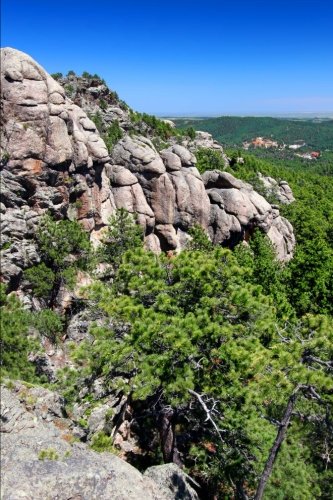Dome Mountains
Category : Soaring Mountains

Black Hills of South Dakota Journal: 150 page lined notebook/diary
Dome mountains are created when a large amount of magma pushes up from below the Earth’s crust, but it never actually reaches the surface and erupts. And then, before it can erupt, the source of the magma goes away and the pushed up rock cools and hardens into a dome shape. Since the dome is higher than its surroundings, erosion works from the top creating a circular mountain range.
Dome mountains are not found in mountain belts such as the Himalayas or the Appalachians. Instead, they are individual, isolated structures that tend to occur in areas of essentially flat-lying sedimentary rocks. These layers are bent upward in a dome shape as a result of uplifting forces. If the rocks above the dome mountain’s center have eroded away, the layers of rock may stand out as sharp ridges around the edge of the mountain.
There are two basic types of dome mountains. One type is called a plutonic dome mountain. The other type is referred to as a tectonic dome mountain.
Plutonic dome mountains form when overlying crustal rocks are pushed upward by an igneous intrusion, such as a laccolith. Because the intrusion occurs after the overlying crustal rocks have been formed, the igneous rock at the core of the mountain is younger than the sedimentary rocks around the core.
Many examples of plutonic dome mountains are found on the border of the Colorado Plateau and the Rocky Mountains.
Tectonic dome mountains result from uplifting forces that arch rock layers upward. All the rocks in the dome were present before the uplift occurred. The rocks at the core extend under the rocks around the dome and, therefore, must be older.
Two examples of tectonic dome mountains are the Adirondack Mountains of New York State and the Black Hills of South Dakota
If you have any information,questions, or feedback you would like to include in this post.
Please email momo19@naturekingdoms.com or leave your comments below.
5 Comments
ADELAIDE BAKU
February 21, 2021 at 5:11 amI THANK YOU FOR PROVIDING THIS VEDIO
Anonymous
April 21, 2021 at 12:08 amI am doing research on Dome mountains. I loved your video and explanation. Thank you
M pezzato
April 21, 2021 at 12:09 amI am doing research on Dome mountains. Thank you for this video and explanation!
Devyn Danos
October 11, 2021 at 10:25 pmThanks, in the middle of mountain research, bogged down and needed this
My Site
July 23, 2022 at 2:14 amSuch great website
Amazing blog thanks for sharing today on this blog